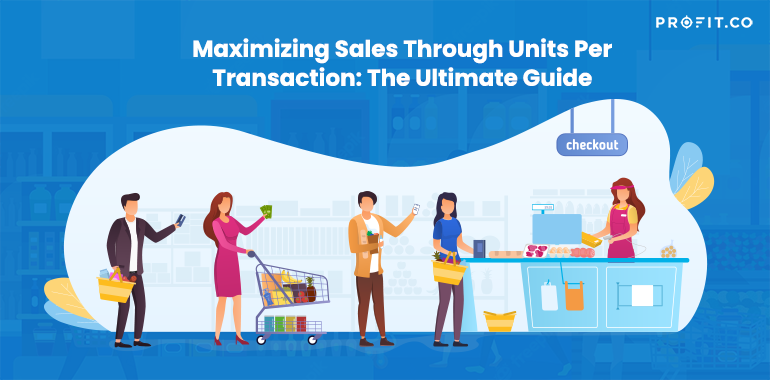Introduction
Imagine walking into your favorite retail store. As a shopper, you’re trying to find that perfect item. Now switch roles – you’re the store owner watching the sea of customers. What’s going through their minds? What makes them fill their baskets? Units Per Transaction (UPT) is the magnifying glass that brings customers’ buying habits into focus. In the world of retail, understanding customer buying behavior is paramount. Units Per Transaction (UPT) is a vital metric that can provide insights into consumer spending patterns.
This guide is your trusty sidekick that breaks down UPT to its core. Let’s l dive into the calculations, real-life examples, and secret strategies that can make UPT an important KPI to track in the retail industry.
What is Units Per Transaction?
Units Per Transaction is a retail metric measuring the average number of items a customer purchases in a transaction. Essentially, it reflects how well your business entices customers to buy more products whenever they shop.
Why is it important?
- Boost sales revenueBy increasing the number of items sold per transaction, you enhance the total sales revenue
- Inventory management Higher UPT indicates faster inventory turnover, which aids in managing inventory more effectively. Improving the Unit Per Transaction (UPT) can lead to a higher inventory turnover ratio as increased sales per transaction result in faster inventory turnover, reducing holding costs and minimizing the risk of obsolete inventory.
- Marketing insight Understanding UPT helps identify what kind of promotions or marketing strategies can encourage bulk buying.
Quality in a service or product is not what you put into it. It is what the customer
gets out of it.
Calculation
Units Per Transaction (UPT) is calculated by dividing the total number of items sold by the total number of transactions.

Real-life example
Let’s say a clothing store has the following sales data for a week
Total Number of Items Sold = 280
Total Number of Transactions = 70
UPT = 280 / 70 = 4
This means that on average, customers purchase four items every time they make a transaction at this store.
Ready to start your KPI journey today?
FAQs
- How can UPT be improved?
UPT can be improved by employing various sales strategies such as bundling, discounts on additional items, or in-store promotions.
- Is a higher UPT always better?
Not necessarily. A higher UPT is generally good, but it’s important to ensure that this does not result from heavy discounting that can erode profits.
- How is UPT different from Average Transaction Value (ATV)?
While UPT measures the average number of items per transaction, ATV represents the average dollar amount spent per transaction.
OKR Example with Key Results and Initiatives
Shopkeepers aim to enhance their Units Per Transaction (UPT) consistently. Here, strategic planning is critical, and Objectives and Key Results (OKRs) are effective tools for implementing this strategy. Shopkeepers can develop practical initiatives by setting a clear objective to raise the average basket size and crafting key results that employ upselling and cross-selling techniques. This structured approach, centered on customer needs, leverages the organization and clarity provided by OKRs, leading to notable improvements in UPT and highlighting the practicality of OKRs in retail management.
Retailers have witnessed remarkable transformations by adopting OKRs and advanced tools like Profit.co. From streamlining inventory management to optimizing sales strategies, OKRs have helped retailers redefine their quarterly priorities, discover growth opportunities, and bring long-awaited projects to fruition. Success is within reach with retail stores’ OKR examples that can be used to enhance the retail stores business.
Objective: Increase Units Per Transaction to Enhance Sales Revenue
Key Result 1: Increase the UPT from 4 to 5.5 by the end of Q2
Initiative:
- Introduce product bundling options.
- Train sales staff to upsell and cross-sell products effectively.
Key Result 2: Achieve a 10% increase in total sales revenue through improved UPT by Q2
Initiative:
- Implement targeted promotions for additional items.
- Regularly analyze sales data to identify trends and optimize product placement.
Key Result 3: Improve customer feedback score regarding product variety and availability by 15%
- Enhance inventory management to ensure product availability.
- Collect and analyze customer feedback to expand product range according to demand.
Best Practices to Improve UPT
Product bundling
Offer discounts on product bundles to encourage customers to buy more.
Effective upselling
Train your staff on the art of upselling without being too aggressive.
Customer loyalty programs
Implement loyalty programs that reward customers for making more significant purchases.
Data analysis
Continuously analyze UPT data to understand customer behavior and adjust strategies accordingly.
Conclusion
In the fast-paced retail environment, understanding customer buying patterns is essential. Units Per Transaction is a crucial metric for retailers to gauge consumer spending habits. By focusing on increasing UPT, retailers can boost sales, improve inventory management, and gain valuable marketing insights. Implement the best practices mentioned above and watch your retail business flourish.

